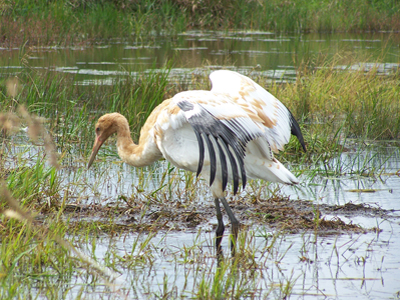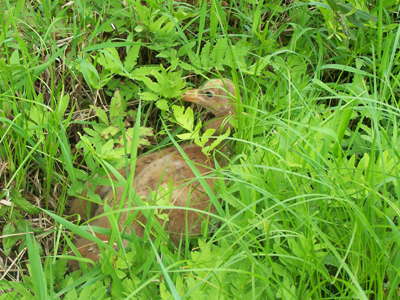| ICF’s Whooping Crane chicks demonstrate that there’s more than one way to stay cool on a hot day, from standing in the water and shading their legs with their wings (top), to playing in their water (middle), and resting in the shade (bottom). |
 |
 |
 |
By Annette Aeschbach, ICF Veterinary Technician
Those of us who work directly with the cranes at ICF often are asked how the birds deal with the cold of Wisconsin winters. This year we have had more questions on how the cranes deal with the abnormally high temperatures Wisconsin endured this summer. From an aviculture stand point, the birds have access to houses that are well insulated and stay relatively cool until mid-day. The birds are often seen in shade found in their yards, as well as getting fresh water every morning and afternoon.
The first thing to consider when it comes to how cranes deal with heat is that a crane’s normal body temperature is 105° F, so they don’t have to shed the extra heat as soon as we do. On the other hand, cranes have that nice insulating layer of feathers, a higher metabolic rate, and an active lifestyle, which creates a lot of body heat. So how do they stay cool in the dog days of summer?
Well, birds don’t have sweat glands to sweat off some of the heat like we do, but they have other really cool adaptations to help:
• Birds will open their mouths and pant like a dog to help expel body heat. Plus bird’s lungs and air sacs are set up as a one way street. So, as the cool air comes in and moves through the system it is warmed up and expelled outside the body. The cool air doesn’t mix with the warm air already in the lungs. This creates a greater cooling capacity, as well as higher oxygen levels.
• A significant amount of heat is lost through their legs because they are not covered in feathers. The birds can also help cool their legs and feet more by standing in the water and/or holding their wings out from their body to shade their legs (top right).
• Holding their wings out from their body also helps to create air circulation around their body, which will help to dissipate the heat.
• They will drink more water and sometimes even play a little more in their water to help keep cool (middle right).
• The cranes will also alter their behavior by foraging more in the morning and evening hours and sitting under the shade during the hottest part of the day (bottom right). Some of our captive birds prefer to go into their houses for their shade.
All of the adaptations used by our captive cranes are utilized by cranes in the wild. If you know of an area that has a pair of cranes, look for them mid-day. You will often find them sitting in the shade of a tree near their favorite field or standing in the water of the marsh they call home.
